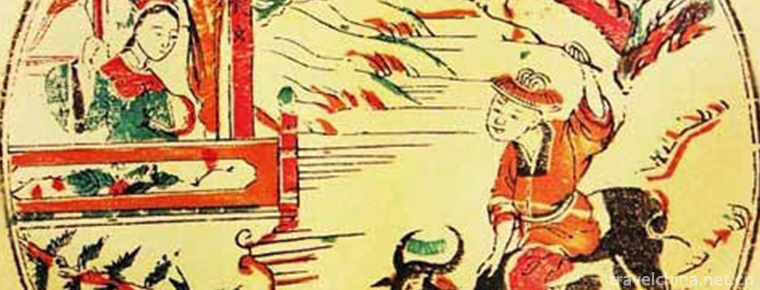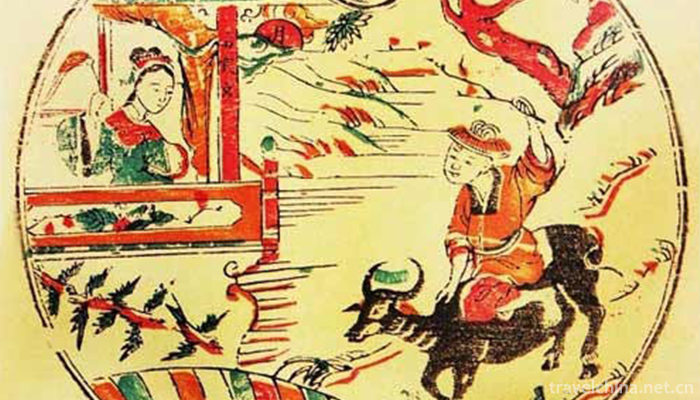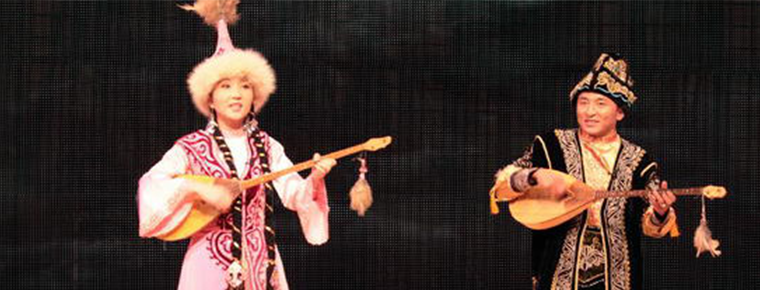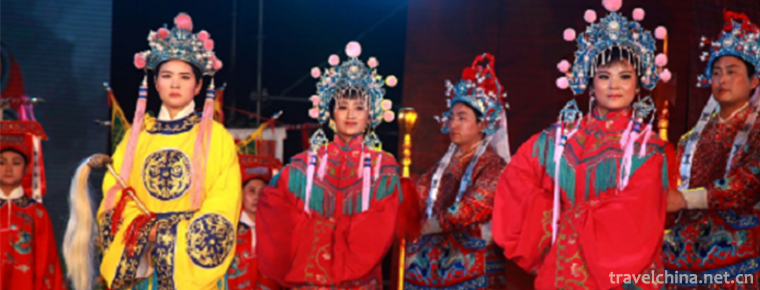2018-12-22

- By ChinaWiki.net
- Chinese Edition
- 2019-04-29
Foshan Wood Engraving New Year Pictures
Foshan woodcut New Year's picture is a famous folk New Year's picture in South China and a wonderful flower of Lingnan traditional folk culture. It is as famous as the New Year Paintings of Yangliuqing in Tianjin, Taohuawu in Suzhou and Huaifang in Shandong. It is one of the four major production bases of Chinese woodcut New Year Paintings in China, and has a great influence on the Chinese settlements in Southeast Asia and other countries in the world. Foshan Municipal Government and Chancheng District have included woodcut New Year pictures in the first batch of key projects.
On May 20, 2006, the heritage was approved by the State Council and listed in the first batch of national intangible cultural heritage list.
development history
As early as the Song and Yuan Dynasties, the custom of carving door gods was prevalent in Guangzhou and Foshan. This kind of door god was painted directly on the door board in the early stage, and then was carved on another board. A large number of copies were made and sold in the market for people to post.
Foshan woodcut New Year Picture was founded in Yongle of Ming Dynasty. After the prosperity of Qing Dynasty, it became a necessary thing for every household in the Pearl River Delta. It has a certain influence in Southeast Asia and Chinese settlements all over the world. It is a representative of the origin of South China New Year Picture. It is named for its production in Foshan, Guangdong Province.
From the reign of Qianlong and Jiajing in the Qing Dynasty to the peak period of the Anti-Japanese War, there were more than 200 shops and thousands of practitioners in Foshan New Year Pictures. At the peak, the single God produced more than 11,000 pairs per day, which became an important handicraft industry in Foshan.
After the 1930s, there was a recession.
After 1966, Foshan New Year paintings were reprimanded as "feudal superstitions" and stopped production.
Production resumed after 1975, mainly for export.
Later, the custom of door-pasting among urban residents became less and less, while the custom of door-pasting still existed in suburbs and counties and countryside.
Subject matter content
The custom of posting New Year pictures on Spring Festival has a long history. Before the Ming Dynasty, people used stone carving tigers and lions to put them in front of their doors or so to show their exorcism. Since the rise of New Year's paintings, people began to post Spring Festival couplets, Spring Festival and door paintings after December 24, commonly known as door gods, as exorcism and happiness.
Foshan woodcut New Year's pictures, as a special form of local activities, reflect the historical roots of Foshan's local culture and some basic conditions of Foshan's traditional folk painting and printing technology.
According to the division of skills, Foshan woodcut New Year pictures include three types: original pictures, woodcut and woodcut brushwork; thematic division, door paintings (commonly known as door gods), God portraits, lantern paintings, Bangbian paintings, and woodcut paintings, commonly known as "Annan paintings" sold exclusively in Vietnam and Cambodia at the beginning of the Republic of China, with door gods New Year pictures as the largest one, whose main functions are sacrifice, prayer and decorative environment, reflecting people's drive. The wish of evil Nafu.
In the past, the themes of Foshan woodcut New Year pictures were mostly "Shen Ta Yu Lei", "Qin Shubao", "Wei Chigong", "Fulu Shouquan", "Money Boy", "He He He Er Xian", "Tian Ji Giving Zi", "Guan Gong", "Bao Gong" and other gods, historical figures and opera stories. The subject matter is very extensive, showing the people's good wishes and ideals. After the founding of the People's Republic of China, Foshan woodcut New Year paintings created a large number of modern themes, such as "three red flags" and "half the sky for women".
artistic characteristics
Foshan New Year Pictures have the same commonalities as those of Yangliuqing in Tianjin, Taohuawu in Jiangsu, Mianzhu in Sichuan and Weifang in Shandong: on themes, they mainly have auspicious patterns, exorcism and greeting auspiciousness, folk customs, opera stories and historical stories. In terms of function, it is mainly used for decorating the environment, rendering the atmosphere, hosting people's desire to leave the old and welcome the new, and receiving fortune. Because New Year's Picture is a local folk art, self-entertainment, reflecting folk life and customs, contains rich folk cultural value. However, due to different geographical, historical and economic development conditions, different cultural backgrounds and social customs are formed in each place, and because of the differences in appreciation habits, aesthetic tastes and modelling concepts, each place has its own strong and distinct local color and strong points. Influenced by Lingnan traditional culture, and catering to the aesthetic taste and living habits of Foshan people, Foshan New Year Pictures are popular among the people with folk beliefs in God paintings, seasonal scenery paintings and ritual and custom paintings.
Foshan woodcut New Year pictures draw lessons from and absorb the folk art production skills of Foshan, such as paper-cut, dyeing paper, copper chisel lining, woodcut paper, shenyi, door calendula and so on. Large-scale use of red, green, yellow, black and other color block overprints makes the picture magnificent and brilliant. Warm and gorgeous Foshan wood engraving New Year's pictures not only imply auspiciousness, but also because Foshan is located in the hinterland of the Pearl River Delta, with long sunshine in summer, hot climate, abundant rainfall, and high humidity of air. The use of Foshan's local production of red and red door painting substrates, known as "Wannian Hong", makes the door painting bright and gorgeous in color, and adds a festive and auspicious atmosphere. At the same time, gold and silver patterns are painted on the armor and robes, which enriches the picture and highlights the unique artistic features of Foshan wood engraving doors.
Foshan woodcut New Year pictures have fine image, rough and concise lines, vigorous and powerful, full composition and decorative, which are obviously different from other local New Year pictures. Its delicacy shows its subtlety, full of its auspicious, rough show its strength, vigorous display of its personality, with strong local characteristics. At the end of the Qing Dynasty, "Records of Zhongyi Township in Foshan" recorded "Menshen Xing", which specializes in producing door paintings, New Year paintings and God statues. It can be seen that it is one of the few art treasures with strong local characteristics in China.
Foshan woodcut New Year's pictures have three kinds: hand-painted, wooden overlay printing and woodcut filling. They are characterized by rough lines, brilliant colors, concise shapes, full composition and strong decoration. The pattern on the figure's dress is rendered with smooth lines of gold and silver, commonly known as "flower painting", which is very rich in the charm of folk paintings. It is rare for folk New Year paintings in other areas and has become a prominent feature of Foshan New Year paintings. In terms of expression, it is good at combining local customs and customs, and has a strong local style. Formally, it meets the needs of the broad masses of the people in many ways. Foshan New Year's Pictures have the delicate artistic characteristics of Guangfu culture in line processing, style, color setting skills and theme selection.
Skill inheritance
The inheritors of Foshan wood engraving New Year pictures are only Feng's family. It is urgent to take effective protective measures to continue the production process of this valuable New Year pictures.
Feng's family is the only surviving representative of woodcut New Year pictures in Foshan, Guangdong. Feng's family created the name of "Feng Junji" from his grandfather Feng Jun and gained the reputation of "Men Shen Jun", and became the representative of Foshan woodcut New Year pictures in the Republic of China. The history of woodcut New Year pictures was interrupted during the Cultural Revolution. Feng Jun broke up more than 200 woodcuts overnight. Since then, Foshan woodcut New Year pictures have declined. Later, the old practitioners have gone out of fashion, and the young ones have changed their professions one after another.
When Feng Bingtang and Feng Jinqiang, descendants of Menshenjun, were still insisting on the production of woodcut New Year pictures. "Feng Junji" has become the representative of Foshan Wood Engraving New Year Painting, which is also the only genuine genre of Wood Engraving New Year Painting in Guangdong Province.
In 1998, with the support of Foshan Folk Art Research Society, Feng's father and son established Foshan Folk Art Society Wood Engraving New Year Painting Workshop, which restored the production of Foshan Wood Engraving New Year Painting.
In 2003, Chinese woodcut New Year pictures became the first priority rescue projects of the government.
On May 20, 2006, Foshan wooden plank New Year pictures were approved by the State Council and included in the first batch of national intangible cultural heritage list.
On June 5, 2007, Feng Bingtang of Foshan City, Guangdong Province, was identified by the Ministry of Culture as the representative successor of this cultural heritage project, and was included in the list of 226 representative successors of the first batch of national intangible cultural heritage projects.

Ask a Question
Your email address will not be published.



0 Questions